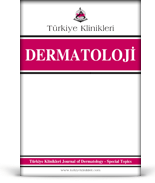Objective: Male genital dermatoses include a wide spectrum of disorders. The aim of this study is to define the male genital dermatoses presenting to dermatology and venereology department. Material and Methods: A total of consecutive 344 male patients with genital lesions attending dermatology and venereology outpatient clinic were included in this prospective descriptive, observational study. Results: The most common diagnosis was condyloma acuminata in 132 (38.3%) patients, followed by scabies in 55 (15.9%) patients and fungal infections in 19 (5.52%) patients. Age of the patients (p=0.001), presence of regular sexual activity (p=0.046) first applied department (p=0.004), presence of associated symptom (p=0.001), extragenital skin involvement (p=0.001), duration of the disease (p=0.001), involvement site (p=0.001) showed significant difference between subgroups when diseases were classified into 4 categories based on the etiology as follows: benign conditions, infectious diseases, inflammatory diseases and premalignant/malignant diseases. Diseases were also evaluated in terms of way of transmission as follows: sexually transmitted diseases, contagious diseases and non-contagious diseases. Age of the patients (p=0.003), education levels of the patients (p=0.001), presence of associated symptom (p=0.001), extragenital skin involvement (p=0.001), duration of the lesion (p=0.002) and the type of the lesion (p<0.01) showed significant difference between these subgroups. Conclusion: Public education programs informing patients about sexually transmitted diseases will be beneficial in reducing sexually transmitted diseases.
Keywords: Condyloma acuminata; genital dermatoses; infectious diseases; neoplasms; sexually transmitted diseases
Amaç: Erkek genital dermatozları geniş bir hastalık yelpazesini içerir. Bu çalışmanın amacı, dermatoloji ve veneroloji polikliniğine başvuran erkek genital dermatozlarını tanımlamaktır. Gereç ve Yöntemler: Bu prospektif, tanımlayıcı, gözlemsel çalışmaya, dermatoloji ve veneroloji polikliniğine genital lezyonlar ile başvuran toplam 344 ardışık erkek hasta dâhil edilmiştir. Bulgular: En sık görülen tanı, 132 hastada (%38,3) kondiloma aküminata olup, bunu 55 hastada (%15,9) uyuz ve 19 hastada (%5,52) fungal enfeksiyonlar takip etmiştir. Hastalar etiyolojiye göre benign durumlar, enfeksiyöz hastalıklar, inflamatuar hastalıklar ve premalign/malign hastalıklar olmak üzere 4 kategoriye ayrıldığında; yaşları (p=0,001), düzenli cinsel aktivite varlığı (p=0,046), ilk başvurulan bölüm (p=0,004), eşlik eden semptomların varlığı (p=0.001), ekstragenital deri tutulumu (p=0,001), hastalık süresi (p=0,001) ve tutulum bölgesi (p=0,001) açısından gruplar arasında anlamlı farklılık izlendi. Hastalıklar ayrıca bulaşma yoluna göre cinsel yolla bulaşan hastalıklar, bulaşıcı hastalıklar ve bulaşıcı olmayan hastalıklar olarak değerlendirildi. Bu gruplar arasında hastaların yaşı (p=0,003), eğitim düzeyleri (p=0,001), eşlik eden semptomların varlığı (p=0,001), ekstragenital deri tutulumu (p=0,001), lezyon süresi (p=0,002) ve lezyon tipi (p<0,01) açısından anlamlı fark bulundu. Sonuç: Cinsel yolla bulaşan hastalıklar konusunda halkı bilgilendiren eğitim programları, cinsel yolla bulaşan hastalıkların azaltılmasında faydalı olacaktır.
Anahtar Kelimeler: Kondiloma aküminata; genital dermatozlar; enfeksiyöz hastalıklar; neoplazmlar; cinsel yolla bulaşan hastalıklar
- Saraswat PK, Garg A, Mishra D, Garg S. A study of pattern of nonvenereal genital dermatoses of male attending skin OPD at a tertiary care center. Indian J Sex Transm Dis AIDS. 2014;35(2):129-34. [PubMed] [PMC]
- Arya M, Kalsi J, Kelly J, Muneer A. Malignant and premalignant lesions of the penis. BMJ. 2013;346:f1149. [PubMed]
- Hillman RJ, Walker MM, Harris JR, Taylor-Robinson D. Penile dermatoses: a clinical and histopathological study. Genitourin Med. 1992;68(3):166-9. [PubMed] [PMC]
- Singhal RR, Nair PA. A study on clinical patterns of nonvenereal male genital dermatoses at a rural-based tertiary care center. Clin Dermatol Rev 2021;5(1):78-84. [Crossref]
- Acharya KM, Ranpara H, Sakhia JJ, Kaur C. A study of 200 cases of genital lesions of non-venereal origin. Indian J Dermatol Venereol Leprol. 1998;64(2):68-70. [PubMed]
- Karthikeyan KE, Jaishankar TJ, Thappa DM. Non‑venereal dermatoses of male genital region‑prevalence and pattern in a referral centre in South India. Indian J Dermatol 2001;46(1):18‑22. [Link]
- Insinga RP, Dasbach EJ, Myers ER. The health and economic burden of genital warts in a set of private health plans in the United States. Clin Infect Dis. 2003;36(11):1397-403. [Crossref] [PubMed]
- Dinh TH, Sternberg M, Dunne EF, Markowitz LE. Genital warts among 18- to 59-year-olds in the United States, national health and nutrition examination survey, 1999--2004. Sex Transm Dis. 2008;35(4):357-60. Erratum in: Sex Transm Dis. 2008;35(8):772-3. [PubMed]
- Jeynes C, Chung MC, Challenor R. 'Shame on you'--the psychosocial impact of genital warts. Int J STD AIDS. 2009;20(8):557-60. [PubMed]
- Smith JS, Backes DM, Hudgens MG, Mei W, Chakraborty H, Rohner E, et al. Male circumcision reduces penile HPV incidence and persistence: a randomized controlled trial in Kenya. Cancer Epidemiol Biomarkers Prev. 2021;30(6):1139-48. [PubMed] [PMC]
- Lluch-Galcerá JJ, Carrascosa JM, Boada A. Epidemic scabies: new treatment challenges in an ancient disease. Actas Dermosifiliogr. 2023;114(2):132-40. English, Spanish. [Crossref] [PubMed]
- Thakur R, Kalsi AS. Updates on genital dermatophytosis. Clin Cosmet Investig Dermatol. 2020;13:743-50. [Crossref] [PubMed] [PMC]
- Yale K, Awosika O, Rengifo-Pardo M, Ehrlich A. Genital allergic contact dermatitis. Dermatitis. 2018;29(3):112-9. [PubMed]
- Goldman BD. Common dermatoses of the male genitalia. Recognition of differences in genital rashes and lesions is essential and attainable. Postgrad Med. 2000;108(4):89-91, 95-6. [Crossref] [PubMed]
- Mallon E, Hawkins D, Dinneen M, Francics N, Fearfield L, Newson R, et al. Circumcision and genital dermatoses. Arch Dermatol. 2000;136(3):350-4. [Crossref] [PubMed]
- Bunker CB, Neill SM. The genital, perianal and umbilical regions. In: Burns T, Breathnach S, Cox N, Griffiths C, eds. Rook?s Textbook of Dermatology. 7th ed. Oxford: Blackwell Science; 2004. p. 68.1‑104. [Crossref] [PubMed]
- Mohapatra L, Nayak S, Pattnaik S, Dash S. Clinical spectrum of non-venereal genital dermatoses in adult males. Anatol J Family Med 2023;6(1):37-41. [Crossref]
- Bunker CB, Shim TN. Male genital lichen sclerosus. Indian J Dermatol. 2015;60(2):111-7. [Crossref] [PubMed] [PMC]
- Puri N, Puri A. A study on non venereal genital dermatoses innorth India. Our Dermatol Online 2013;3(4):304‑7. [Crossref]
- Hogade AS, Mishra S. A study of pattern of nonvenereal genital dermatoses of male attending skin OPD of tertiary centre in Kalaburagi. Int J Res Dermatol 2017;3:407‑10. [Crossref]
- Talamala SPK, Gummadi P, Vatti GP. A clinical study of patterns of non venereal genital dermatoses of adult males in a tertiary care center. IOSR J Dent Med Sci 2016;15(1):47‑50. [Link]







.: İşlem Listesi